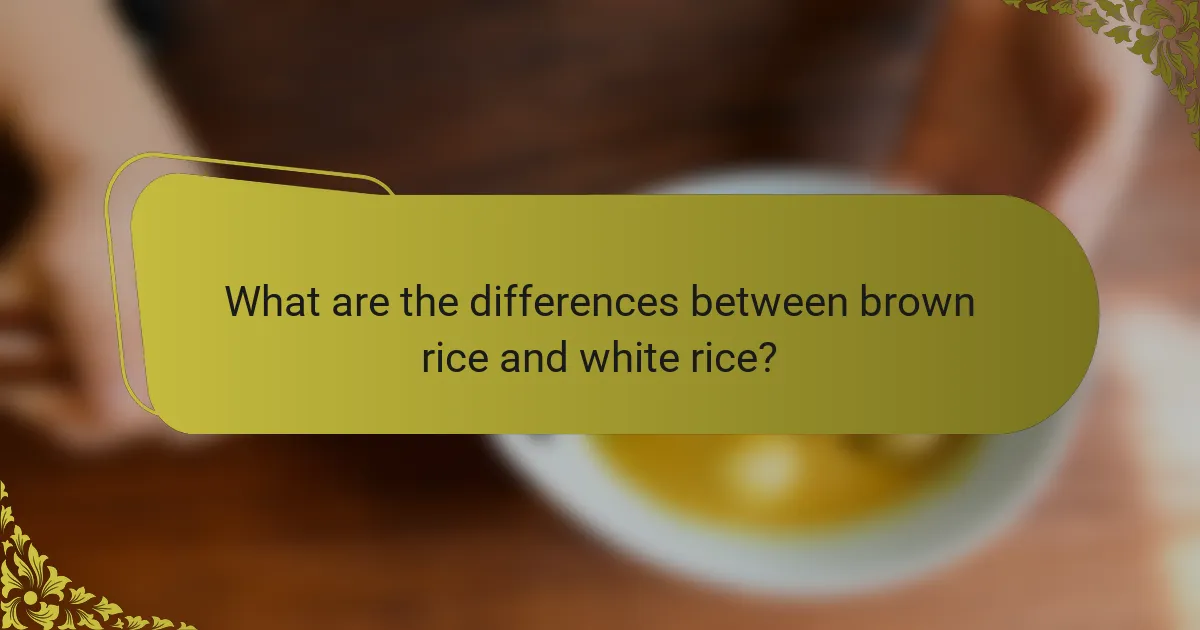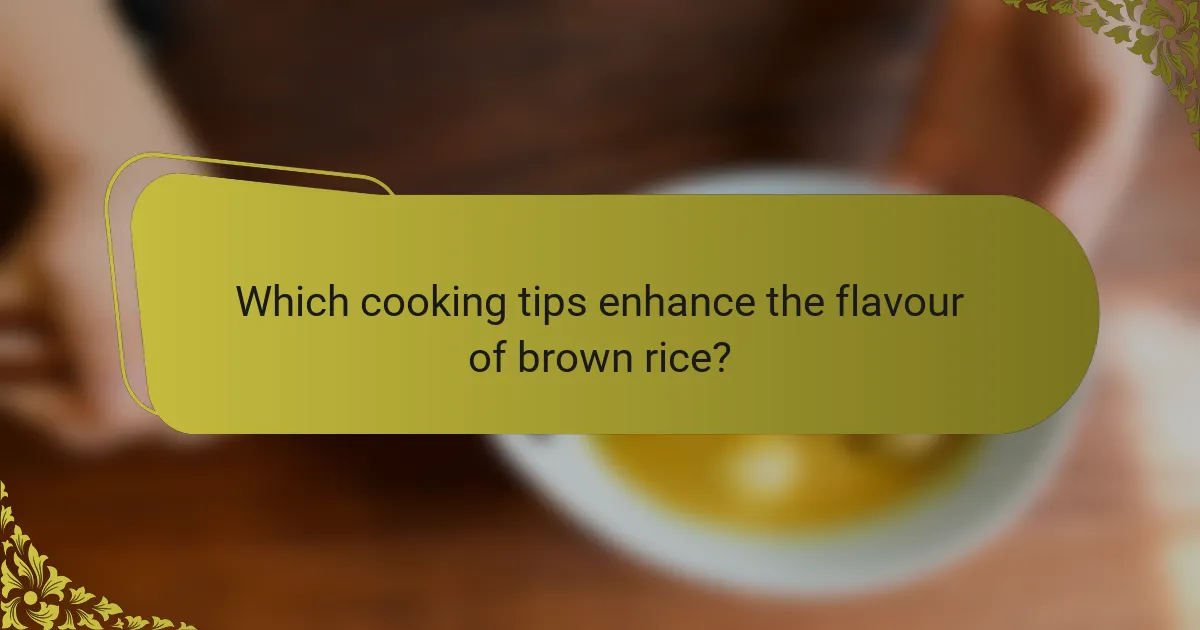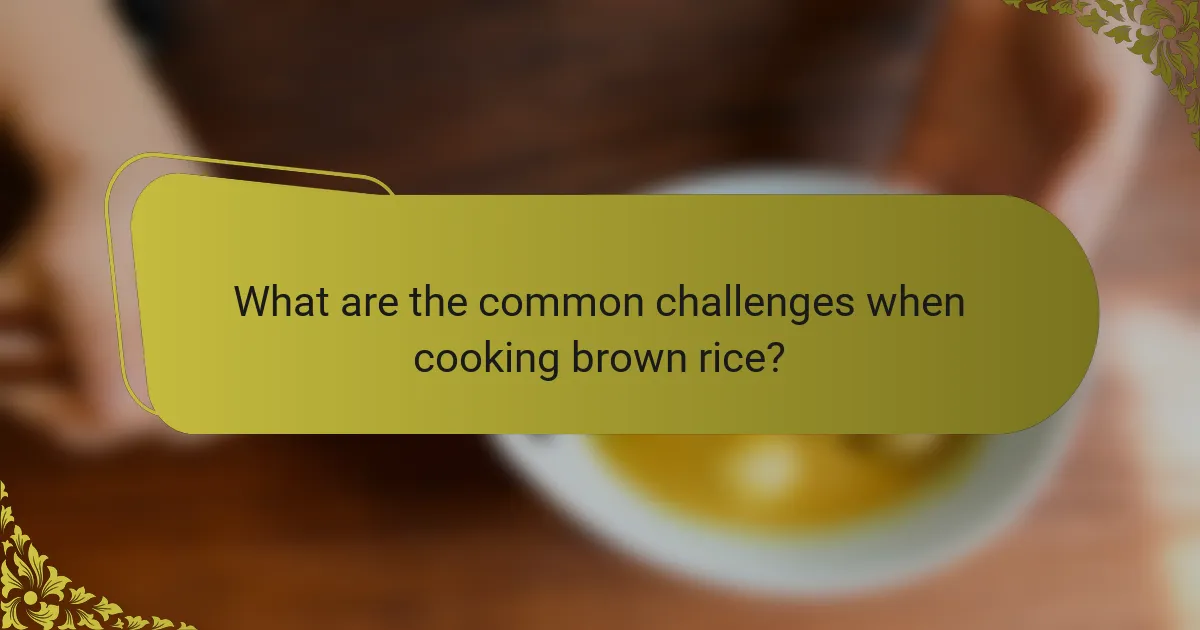Brown rice is a nutritious gluten-free grain that offers significant health benefits, including improved digestion and heart health. This article explores its high fibre content, versatile cooking methods, and unique varieties to enhance your gluten-free meals. Learn how to incorporate brown rice into your diet while overcoming common cooking challenges.

What are the health benefits of brown rice?
Brown rice offers numerous health benefits, including improved digestion, heart health, and weight management. It is rich in fibre, antioxidants, and essential nutrients. The whole grain retains its bran and germ, providing more vitamins and minerals compared to white rice. Brown rice can help regulate blood sugar levels due to its low glycaemic index. Additionally, its magnesium content supports bone health and reduces the risk of chronic diseases.
How does brown rice support digestive health?
Brown rice supports digestive health primarily due to its high fibre content. Fibre aids in regular bowel movements and prevents constipation. Additionally, the presence of prebiotics in brown rice nourishes beneficial gut bacteria, enhancing overall gut health. Regular consumption can lead to improved digestion and reduced gastrointestinal discomfort.
Which nutrients are abundant in brown rice?
Brown rice is rich in essential nutrients such as fibre, magnesium, phosphorus, and B vitamins. These nutrients contribute to improved digestion, heart health, and energy metabolism. Brown rice contains approximately 3.5 grams of fibre per cup, promoting satiety and digestive health. Additionally, its magnesium content supports bone health and muscle function.
Why is brown rice a great option for weight management?
Brown rice is an excellent option for weight management due to its high fibre content and low glycaemic index. This combination promotes satiety and helps regulate blood sugar levels. A cup of cooked brown rice contains about 3.5 grams of fibre, which aids digestion and can prevent overeating. Additionally, brown rice is nutrient-dense, providing essential vitamins and minerals that support overall health. Substituting white rice with brown rice can lead to healthier meal choices and contribute to weight loss goals.
How does brown rice contribute to heart health?
Brown rice contributes to heart health by providing essential nutrients, fibre, and antioxidants. Its high fibre content helps lower cholesterol levels, reducing heart disease risk. Additionally, brown rice contains magnesium, which supports healthy blood pressure. Incorporating brown rice into a balanced diet can promote overall cardiovascular wellness.

How can brown rice be incorporated into gluten-free meals?
Brown rice can be easily incorporated into gluten-free meals as a versatile base or ingredient. It serves as a nutritious alternative to wheat-based grains, offering essential nutrients and fibre.
1. Use brown rice as a grain bowl base, topped with vegetables, proteins, and sauces.
2. Incorporate it into soups or stews for added texture and heartiness.
3. Create brown rice salads with fresh ingredients and dressings for a refreshing side dish.
4. Substitute brown rice in stir-fries, pairing it with gluten-free soy sauce and vegetables.
5. Prepare brown rice cakes or patties as a gluten-free snack or appetizer.
These methods highlight brown rice’s unique attributes, such as its high fibre content and nutty flavour, making it a beneficial addition to gluten-free diets.
What are some easy brown rice recipes for gluten-free diets?
Brown rice is a versatile ingredient suitable for gluten-free diets. Here are some easy recipes:
1. Brown Rice Salad: Combine cooked brown rice with diced vegetables, olive oil, and lemon juice for a refreshing dish.
2. Stir-Fried Brown Rice: Sauté vegetables and protein of choice, then mix in cooked brown rice and soy sauce.
3. Brown Rice Soup: Simmer brown rice with vegetable broth, herbs, and your favourite vegetables for a comforting soup.
4. Brown Rice Casserole: Layer cooked brown rice with beans, cheese, and spices, then bake until bubbly.
5. Brown Rice Pudding: Cook brown rice with almond milk, sweetener, and cinnamon for a delicious dessert.
These recipes highlight the health benefits of brown rice while accommodating gluten-free needs.
How does cooking method affect the texture of brown rice?
Cooking method significantly influences the texture of brown rice. Techniques such as boiling, steaming, or baking yield different results in firmness and chewiness. Boiling often produces softer grains, while steaming retains a firmer texture. Cooking time and water-to-rice ratio also affect the final texture, with longer cooking times generally leading to a softer outcome.
Which spices and ingredients pair well with brown rice?
Brown rice pairs well with spices and ingredients like garlic, ginger, turmeric, cumin, and herbs such as coriander and parsley. These enhance flavour and provide additional health benefits. For example, turmeric contains curcumin, known for its anti-inflammatory properties.

What are the differences between brown rice and white rice?
Brown rice is generally considered healthier than white rice due to its higher fibre content and nutrient density. Brown rice retains the bran and germ layers, providing essential minerals and antioxidants, while white rice is stripped of these components. Brown rice has a nuttier flavour and chewier texture, requiring longer cooking times. White rice cooks faster and has a softer texture, making it a preferred choice in many dishes. Additionally, brown rice has a lower glycaemic index, promoting better blood sugar control compared to white rice.
How does the nutritional profile compare between brown and white rice?
Brown rice is nutritionally superior to white rice, offering more fibre, vitamins, and minerals. Brown rice contains approximately 3.5 grams of fibre per cup, while white rice has less than 1 gram. Additionally, brown rice retains its bran and germ, providing essential nutrients like magnesium and B vitamins. White rice is often enriched but lacks the same nutritional density as brown rice.
What are the culinary uses of brown rice versus white rice?
Brown rice offers a nuttier flavour and higher fibre content compared to white rice, making it a healthier option for gluten-free meals. Brown rice retains its bran and germ layers, providing essential nutrients like magnesium and B vitamins. In culinary uses, brown rice is ideal for salads, grain bowls, and stir-fries, while white rice suits delicate dishes like sushi and risotto. Cooking times differ; brown rice typically requires longer cooking due to its intact bran layer, usually around 45 minutes, compared to white rice’s 15-20 minutes.

Which cooking tips enhance the flavour of brown rice?
To enhance the flavour of brown rice, consider using broth instead of water, adding spices, and soaking the rice. Cooking brown rice in vegetable or chicken broth adds depth. Incorporating spices like garlic, onion, or bay leaves elevates taste. Soaking the rice for at least 30 minutes helps improve texture and flavour absorption.
How can soaking brown rice improve its cooking quality?
Soaking brown rice improves its cooking quality by enhancing texture and reducing cooking time. This process allows grains to absorb water, leading to softer and fluffier rice. Additionally, soaking can help eliminate phytic acid, increasing nutrient availability. The ideal soaking duration ranges from 30 minutes to a few hours, depending on the desired outcome.
What are the best practices for storing brown rice?
Store brown rice in a cool, dry place in an airtight container to maintain freshness. Use glass or plastic containers to protect it from moisture and pests. Brown rice has a shorter shelf life than white rice, typically lasting about six months to a year. For extended storage, consider refrigeration or freezing, which can prolong its freshness significantly. Always check for any off odours or discolouration before use, as these can indicate spoilage.
How does rinsing brown rice impact its cooking process?
Rinsing brown rice removes excess starch, which prevents clumping and improves texture. This process can lead to fluffier grains and more even cooking. Additionally, rinsing may help reduce some surface contaminants. Overall, rinsing enhances the cooking process by promoting better absorption of water and flavour.

What are the common challenges when cooking brown rice?
Common challenges when cooking brown rice include longer cooking time, water absorption issues, and potential for a chewy texture. Brown rice requires more water and time compared to white rice due to its outer bran layer. This can lead to undercooked or overcooked rice if not monitored closely. Additionally, achieving the desired fluffiness can be tricky, as it may clump together if not stirred properly during cooking.
How can you prevent brown rice from becoming mushy?
To prevent brown rice from becoming mushy, rinse it thoroughly before cooking and use the right water-to-rice ratio. Cooking with a 1:2 ratio of rice to water usually yields the best texture. Additionally, avoid overcooking by monitoring the cooking time closely. Allow the rice to rest after cooking to enhance its firmness.
What should you do if brown rice is undercooked?
If brown rice is undercooked, you should add a small amount of water and continue cooking it on low heat. This allows the rice to absorb moisture and soften further. Check for doneness periodically to avoid overcooking. Brown rice typically takes longer to cook than white rice due to its outer bran layer, which provides health benefits like fibre and essential nutrients. If you find yourself frequently undercooking brown rice, consider adjusting your cooking time or method for better results.
How can you adjust cooking times for different varieties of brown rice?
Adjust cooking times for different varieties of brown rice by following specific guidelines. Short-grain brown rice typically requires 40-45 minutes, while long-grain varieties take around 45-50 minutes. Medium-grain brown rice falls in between, needing about 45 minutes. Soaking rice beforehand can reduce cooking time by approximately 10 minutes. Always adjust water ratios based on the rice type; for instance, use 2.5 cups of water per cup of long-grain brown rice.

Which unique varieties of brown rice are worth trying?
Some unique varieties of brown rice worth trying include Thai Jasmine brown rice, which offers a fragrant aroma, and Bhutanese red rice, known for its nutty flavour and vibrant colour. Other notable options are black rice, rich in antioxidants, and short-grain brown rice, prized for its sticky texture. Each variety enhances gluten-free meals with distinct tastes and nutritional benefits.
What distinguishes Jasmine and Basmati brown rice?
Jasmine rice has a distinct floral aroma and slightly sticky texture, while Basmati rice is known for its long grains and nutty flavour. Both types of brown rice offer health benefits, including high fibre content and gluten-free properties. Jasmine rice typically cooks faster, while Basmati requires more water and time.
How do specialty brown rice varieties enhance culinary experiences?
Specialty brown rice varieties enhance culinary experiences by offering diverse flavours, textures, and nutritional profiles. Varieties like Basmati and Jasmine provide unique aromatic qualities, while black and red rice add visual appeal and health benefits. These differences can elevate dishes, making meals more interesting and satisfying. Additionally, specialty brown rice often retains higher fibre content, promoting better digestion and overall health. Experimenting with various types can inspire creativity in gluten-free cooking, enriching both taste and presentation.
What are the rare attributes of heirloom brown rice varieties?
Heirloom brown rice varieties possess rare attributes that enhance their uniqueness. These include distinct flavour profiles, such as nuttiness or earthiness, and varying cooking times that differ from common rice types. Additionally, some heirloom varieties may exhibit unique colours and textures, contributing to their culinary appeal.
What are expert tips for perfecting brown rice dishes?
To perfect brown rice dishes, focus on soaking, proper water ratios, and seasoning. Soaking brown rice for 30 minutes enhances texture and reduces cooking time. Use a water-to-rice ratio of 2:1 for optimal results. Seasoning with herbs, spices, or broth elevates flavour, making the dish more enjoyable. Additionally, consider adding vegetables or proteins for a balanced meal.
